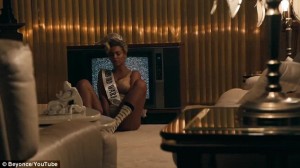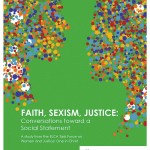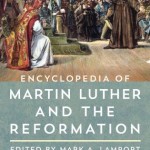Jessica Valenti called Beyoncé’s recent self-titled release “the album that is going to launch a thousand women’s studies papers.” I don’t know how many papers have been written so far, but I do know that the timing couldn’t have been better for my teaching theory in gender and women’s studies this spring. There’s even an essay question about it on our exam today.
We began by talking about the marketing and the message: Seizing control of the means of production (Marxist feminism) and embedding unmistakable feminist messages like the sample of Chimamanda Adichie’s TED talk on feminism. And simply telling girls that they are, indeed, flawless when they wake up:
We returned from time to time to the fact that Beyoncé embraces and performs her sexuality. Is this a good thing (radical libertarian feminism) or a problematic thing that supports patriarchal objectification of women (radical cultural feminism)? We watched her performance of Drunk in Love with Jay Z at the Grammys. How does it compare to Miley Cyrus and Robin Thicke at the 2013 Video Music Awards? What role does race play? Does it matter that we know they’re married?
http://www.youtube.com/watch?v=fG-Qser6IScWe even went back into the Beyoncé vault with the 2011 video for Girls (Run the World), discussing whether or not the troupe of women dancing before the lineup of militarized men subverts the established order and the male gaze, or whether it’s inversion of self and other provides a visual example of existentialist feminism in practice.
Among other things, postmodern feminism talks about Michel Foucault’s concept of the Panopticon and the ways that patriarchy subjects women to surveillance in terms of everything they do. So we turned to Pretty Hurts, the first track on the newest album. Set in the pageant world (“pageant the pain away”) and depicting the distorting effects of plastic surgery, disordered eating, and the overwhelming pressure to be pretty, the audience is urged to consider: if “perfection is the disease of a nation,” what’s the cure?
In both Flawless and Pretty Hurts, Beyoncé embeds video of herself as a younger girl in various competitions and contests. The image of six black girls (Girls TYME!) losing Star Search in 1993 to a group of white men highlights the way race has been a continual factor in her work in this industry. One student read and reported on Sheri’s article at the Crunk Feminist Collective on the video for No Angel, and its representations of poverty and working people in Houston, Beyoncé’s hometown. It’s connections to black feminism (Patricia Hill Collins) and discussions of intersectionality (Kimberle Crensaw) make complex structural analysis visible.
If you know your Beyoncé, consider all that we didn’t even get to: Survivor, Bootylicious, Single Ladies, If I Were A Boy, the 2013 SuperBowl Halftime Show … . Then you’ll know why I considered retitling my feminist theory course Beyoncé Studies, and considered it a great moment when a student asked in class discussion halfway through the semester: What Would Beyoncé Do?













